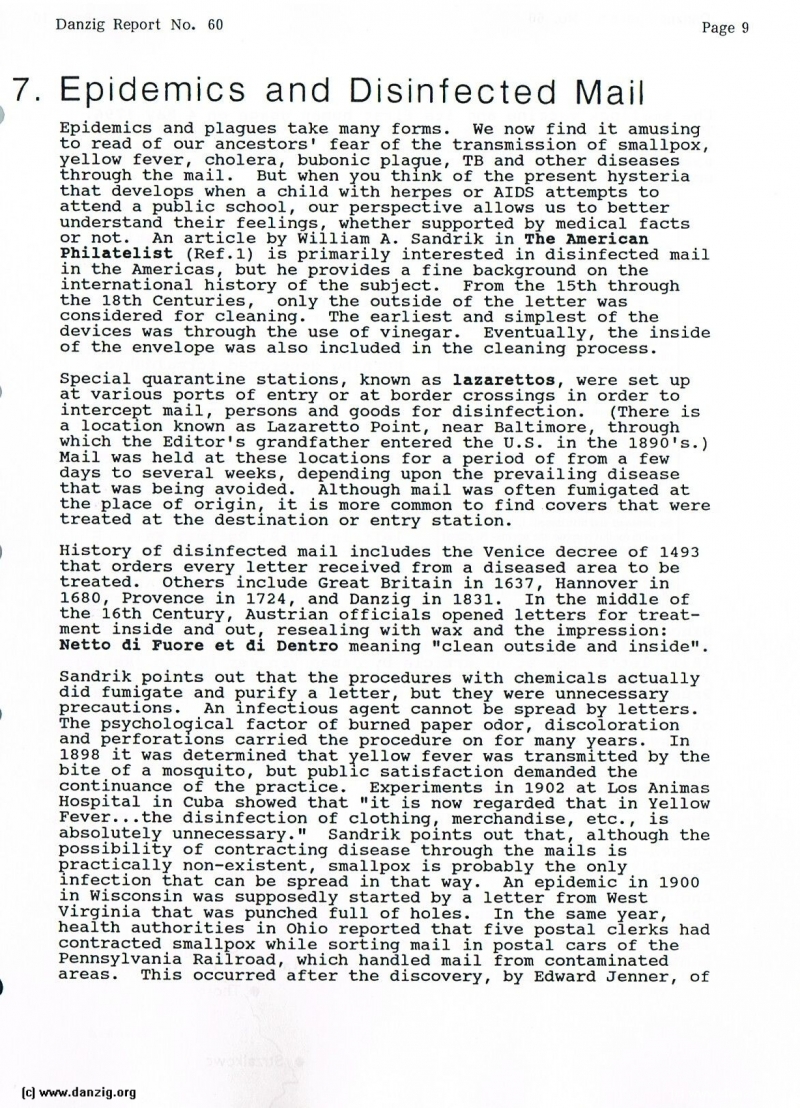
7. Epidemics and Disinfected Mail
Epidemics and plagues take many forms. We now find it amusing to read of our ancestors’ fear of the transmission of smallpox, yellow fever, cholera, bubonic plaue, TB and other diseases through the mail. But when you think of the present hysteria that develops when a child with herpes or AIDS attempts to attend a public school, our perspective allows us to better understand their feelings, whether supported by medical facts or not. An article by William A. Sandrik in The American Philatelist (Ref. 1) is primarily interested in disinfected mail in the Americas, but he provides a fine background on the international history of the subject. From the 15th through the 18th Centuries, only the outside of the letter was
considered for cleaning. The earliest and simplest of the devices was through the use of vinegar. Eventually, the inside of the envelope was also included in the cleaning process.
Special quarantine stations, known as lazarettos, were set up at various ports of entry or at border crossings in order to intercept mail, persons and goods for disinfection. (There is a location known as Lazaretto Point, near Baltimore, through which the Editor’s grandfather entered the U.S. in the 1890’s.) Mail was held at these locations for a period of from a few days to several weeks, depending upon the prevailing disease that was being avoided. Although mail was often fumigated at the place of origin, it is more common to find covers that were treated at the destination or entry station.
History of disinfected mail includes the Venice decree of 1493 that orders every letter received from a diseased area to be treated. Others include Great Britain in 1637, Hannover in 1680, Provence in 1724, and Danzig in 1831. In the middle of the 16th Century, Austrian officials opened letters for treatment inside and out, resealing with wax and the impression: Netto di Fuore et di Dentro meaning “clean outside and inside”.
Sandrik points out that the procedures with chemicals actually did fumigate and purify a letter, but they were unnecessary precautions. An infectious agent cannot be spread by letters. The psychological factor of burned paper odor, discoloration and perforations carried the procedure on for many years. In 1898 it was determined that yellow fever was transmitted by the bite of a mosquito, but public satisfaction demanded the continuance of the practice. Experiments in 1902 at Los Animals Hospital in Cuba showed that “it is now regarded that in Yellow Fever... the disinfection of clothing, merchandise, etc., is absolutely unnecessary.” Sandrik points out that, although the possibility of contracting disease through the mails is practically non-existent, smallpox is probably the only infection that can be spread in that way. An epidemic in 1900 in Wisconsin was supposedly started by a letter from West Virginia that was punched full of holes. In the same year, health authorities in Ohio reported that five postal clerks had contracted smallpox while sorting mail in postal cars of the Pennsylvania Railroad, which handled mail from contaminated areas. This occurred after the discovery, by Edward Jenner, of
Danzig Report Nr. 60 - July - August - September - 1988, Page 9.
Hits: 1873
Added: 26/06/2015
Copyright: 2024 Danzig.org

